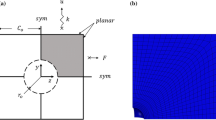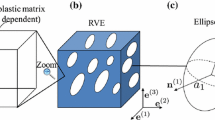Abstract
This work examines the void growth and coalescence in isotropic porous elastoplastic solids with sigmoidal material hardening via finite element three-dimensional unit cell calculations. The investigations are carried out for various combinations of stress triaxiality ratio (\({\mathcal {T}}\)) and Lode parameter (\({\mathcal {L}}\)) and consider a wide range of sigmoidal hardening behaviors with nominal hardening rates spanning two decades. The effect of \({\mathcal {L}}\) is considered in the presence and in the absence of imposed shear stress. Our findings reveal that depending on the nature of sigmoidal hardening the cell stress-strain responses may exhibit two distinct transitions with increasing stress triaxiality (\({\mathcal {T}}\)). Below a certain lower threshold triaxiality the stress-strain responses are sigmoidal, while above a certain higher triaxiality they exhibit softening immediately following the yield. Between these threshold levels, the responses exhibit an apparent classical rather than sigmoidal strain hardening. The sigmoidal hardening characteristics also influence porosity evolution, which may stagnate before a runaway growth up to final failure. For a given \({\mathcal {L}}\), an imposed shear stress adversely affects the material ductility at moderate \({\mathcal {T}}\) whereas at high \({\mathcal {T}}\) it improves the ductility. Finally, we discuss the role of material hardening and stress state on the residual cell ductility defined as strain to final failure beyond the onset of coalescence.











Similar content being viewed by others
Notes
We note that \(\hat{s} = 0.9\) shows similar characteristics as \(\hat{s} = 0.8\).
Results for \({\mathcal {L}}=1.0\) are not included as in all the cases, \(E_{\textrm{c}}\) is attained when \(\chi = \chi _{\textrm{crit}}\), which occurs at very large values of \(E_\textrm{eq}\).
References
Asim UB, Siddiq MA, Kartal ME (2019) Representative volume element (RVE) based crystal plasticity study of void growth on phase boundary in titanium alloys. Comput Mater Sci 161:346
Bao Y, Wierzbicki T (2004) On fracture locus in the equivalent strain and stress triaxiality space. Int J Mech Sci 46(1):81
Barsoum I, Faleskog J (2011a) Micromechanical analysis on the influence of the Lode parameter on void growth and coalescence. Int J Solids Struct 48(6):925
Barsoum I, Faleskog J (2011b) Micromechanical analysis on the influence of the Lode parameter on void growth and coalescence. Int J Solids Struct 48(6):925
Benzerga AA (2023) On the structure of poroplastic constitutive relations. J Mech Phys Solids 178:105344
Dæhli LEB, Tekoğlu C, Morin D, Børvik T, Hopperstad OS (2022) Ductile failure predictions using micromechanically-based computational models. J Mech Phys Solids 164:104873
Dunand M, Mohr D (2014) Effect of Lode parameter on plastic flow localization after proportional loading at low stress triaxialities. J Mech Phys Solids 66:133
Haltom S, Kyriakides S, Ravi-Chandar K (2013) Ductile failure under combined shear and tension. Int J Solids Struct 50(10):1507
Indurkar PP, Joshi SP (2019) Void growth and coalescence in porous plastic solids with sigmoidal hardening. J Appl Mech 86(9)
Indurkar PP, Baweja S, Perez R, Joshi SP (2020) Predicting textural variability effects in the anisotropic plasticity and stability of hexagonal metals: application to magnesium and its alloys. Int J Plast 132:102762
Indurkar PP, Joshi SP, Benzerga AA (2022) On the micromechanics of void mediated failure in HCP crystals. J Mech Phys Solids 165:104923
Kelley EW, Hosford WF (1967) The plastic deformation of magnesium: technical report
Kondori B, Madi Y, Besson J, Benzerga A (2019) Evolution of the 3D plastic anisotropy of HCP metals: experiments and modeling. Int J Plast 117:71
Koplik J, Needleman A (1988) Void growth and coalescence in porous plastic solids. Int J Solids Struct 24(8):835
Lecarme L, Tekog C, Pardoen T et al (2011) Void growth and coalescence in ductile solids with stage III and stage IV strain hardening. Int J Plast 27(8):1203
Liu Z, Wong W, Guo T (2016) Void behaviors from low to high triaxialities: transition from void collapse to void coalescence. Int J Plast 84:183
Pedicini A, Farris RJ (2003) Mechanical behavior of electrospun polyurethane. Polymer 44(22):6857
Rice JR, Rosengren G (1968) Plane strain deformation near a crack tip in a power-law hardening material. J Mech Phys Solids 16(1):1
Scales M, Tardif N, Kyriakides S (2016) Ductile failure of aluminum alloy tubes under combined torsion and tension. Int J Solids Struct 97:116
Selvarajou B, Joshi SP, Benzerga AA (2019) Void growth and coalescence in hexagonal close packed crystals. J Mech Phys Solids 125:198
Tekoglu C (2014) Representative volume element calculations under constant stress triaxiality, lode parameter, and shear ratio. Int J Solids Struct 51(25–26):4544
Torki ME, Benzerga AA (2018) A mechanism of failure in shear bands. Extreme Mech Lett 23:67
Torki M, Keralavarma S, Benzerga A (2021) An analysis of Lode effects in ductile failure. J Mech Phys Solids 153:104468
Tracey DM (1971) Strain-hardening and interaction effects on the growth of voids in ductile fracture. Eng Fract Mech 3(3):301
Vigneshwaran R, Benzerga A (2022 ) A predictive multisurface approach to damage modeling in Mg alloys. In: Magnesium technology. Springer, Berlin, pp 293–297
Vigneshwaran R, Benzerga A (2023) An analysis of failure in shear versus tension. Eur J Mech-A/Solids, p 105074
Vigneshwaran R, Benzerga A (2023) Assessment of a two-surface plasticity model for hexagonal materials. J Magnes Alloys
Vishwakarma V, Keralavarma SM (2019) Effect of Lode parameter on plastic flow localization after proportional loading at low stress triaxialities. Int J Solids Struct 166:135
Wong W, Guo T (2015) On the energetics of tensile and shear void coalescences. J Mech Phys Solids 82:259
Yerra S, Tekog C, Scheyvaerts F, Delannay L, Van Houtte P, Pardoen T et al (2010) Void growth and coalescence in single crystals. Int J Solids Struct 47(7–8):1016
Zhang S, Feng Z, Zhang S, Zhang B, Liu W, Zhang N, Chen S, Luo S (2023) Synchrotron-based multiscale study on phase transformation in a cold-rolled NiTi shape memory alloy: effects of preexisting defects. Int J Mech Sci 238:107862
Zhu Y, Engelhardt MD, Kiran R (2018) Combined effects of triaxiality, Lode parameter and shear stress on void growth and coalescence. Eng Fract Mech 199:410
Acknowledgements
SD and SPJ acknowledge the support provided by the National Science Foundation under Grant Number CMMI-1932976. The authors acknowledge the use of the Carya Cluster and the advanced support from the Research Computing Data Core at the University of Houston to carry out the research presented here.
Author information
Authors and Affiliations
Contributions
S.J. conceptualized the research problem; analyzed results, wrote and edited the main manuscript, secured funding. S.D. performed simulations, analyzed results, prepared figures, wrote a draft manuscript. Both authors reviewed the manuscript.
Corresponding author
Ethics declarations
Conflict of interest
The authors declare that they have no conflict of interest.
Additional information
Publisher's Note
Springer Nature remains neutral with regard to jurisdictional claims in published maps and institutional affiliations.
Implementation of kinematic periodicity and constant stress ratios
Implementation of kinematic periodicity and constant stress ratios
The computational implementation for the kinematic periodic boundary conditions and constant stress ratios closely follows Ref. Tekoglu (2014). For completeness, the procedure is briefly described in the following sections.
1.1 No shear stress (\(\rho _{\textrm{xy}} = 0\))
1.1.1 Kinematic periodic boundary conditions
Referring to Fig. 2, five pairs of dummy nodes \((T, T')\), \((R, R')\), \((L, L')\), \((F, F')\), and \((B, B')\) are defined respectively for the top, right, left, front, and the back faces. Each pair is connected by a linear spring element \(T-T'\), \(L-L'\), \(R-R'\), \(F-F'\) and \(B-B'\), of stiffness k which is taken to be equal to 60, 000 N/mm. The node in the center of the bottom face is fixed to avoid rigid body movement. The force in the springs is transferred to the unit cell. For equilibrium, the forces in the \(L-L'\) and \(F-F'\) are equal to \(R-R'\) and \(B-B'\) respectively. With u, v, and w as the displacement components along the X, Y, and Z directions, the displacement of one end of the spring is coupled with that of the faces as follows:
where the superscript i represents the nodes on the face indicated in the subscript. Note that \(v^i_{bottom} = 0\). The nodes L and R (similarly F and B) act as master nodes for the left and right (similarly front and back faces). Eq. (3) ensures periodicity along the three coordinate directions.
1.1.2 Imposing constant axial stress ratios (\(\rho _{\textrm{xx}}, \rho _{\textrm{zz}}\))
The volume-averaged macroscopic stresses can be defined in terms of the spring forces as:
where \(F_i\) and \(A_i\) are the force in the spring applied normal to the face i with area \(A_i\). From there, the stress ratios \(\rho _{\textrm{xx}}\) and \(\rho _{\textrm{zz}}\) are written as:
The stress ratios are kept constant by introducing Eq. 5a and 5b as multi-point constraints using an MPC user subroutine in ABAQUS/STANDARD®.
Note that, \(v_{T'}\) is the only prescribed input, which is prescribed via the user-prescribed boundary condition. From that, ABAQUS/STANDARD® computes the displacements \(u_R\), \(u_{R'}\), \(u_L\), \(u_{L'}\), \(v_T\), \(w_{F}\), \(w_{F'}\), \(w_{B}\), and \(w_{B'}\) at each time increment.
1.2 Imposed shear stress (\(\rho _{\textrm{xy}} \ne 0\))
To apply a shear stress along with the axial stresses, an additional pair of dummy nodes \((S, S')\) is defined to which a linear spring element \(S-S'\) of the same stiffness k is connected, Fig. 2. For brevity, here we describe the procedure to maintain constant \(\rho _{\textrm{xx}}\) and \(\rho _{\textrm{xy}}\).
1.2.1 Kinematic periodic boundary conditions
The displacement of the node S is coupled to the unit cell such that periodicity is ensured in the presence of an imposed shear stress. For this, the boundary conditions adopted are as follows:
1.2.2 Imposing constant shear stress ratio (\(\rho _{\textrm{xy}}\))
The macroscopic shear stress is given in terms of the spring force by:
where \(F_{\textrm{shear}}\) is the force in the spring S-S’ (Fig. 2). Then, the shear stress ratio is:
As the current framework considers a finite deformation setting, the foregoing description accounts for the normal stress that arises due to the imposition of the shear stress (referred to as the Poynting effect).
Consider the case of simple shear with a shear constant \(\gamma \). The total deformation gradient \({\textbf{F}}\) is:
The velocity gradient (L = D + W) is:
The Jaumann rate of Cauchy stress (\(\mathbf {{\bar{\sigma }}}\)) is expressed as:
where C is the elasticity tensor and \({\textbf{D}}^e\) is the elastic rate-of-deformation.
In a more general setting where axial stresses are imposed in addition to the shear stress the additional axial stress caused by shear straining must be included. For example, the total axial stress along the X-direction is given by:
From this, we obtain \(\rho _{xx}\) on the right face as:
and on the left face,
Similar expressions can also be derived for \(\rho _{\textrm{zz}}\) on the front and back faces. These stress ratios are maintained by introducing 8 and 13a, 13b in addition to 5b as a constraint in the MPC subroutine.
Rights and permissions
Springer Nature or its licensor (e.g. a society or other partner) holds exclusive rights to this article under a publishing agreement with the author(s) or other rightsholder(s); author self-archiving of the accepted manuscript version of this article is solely governed by the terms of such publishing agreement and applicable law.
About this article
Cite this article
Datta, S., Joshi, S.P. Void growth and coalescence in sigmoidal hardening porous plastic solids under tensile and shear loading. Int J Fract (2024). https://doi.org/10.1007/s10704-024-00768-5
Received:
Accepted:
Published:
DOI: https://doi.org/10.1007/s10704-024-00768-5
Keywords
- Sigmoidal material hardening
- Ductile damage
- Void growth and coalescence
- Tensile and shear loading
- Magnesium alloys




